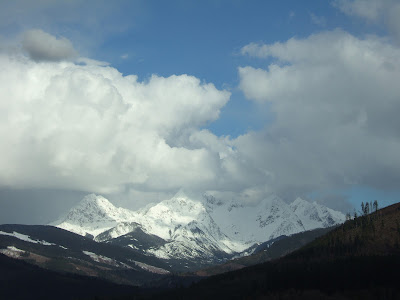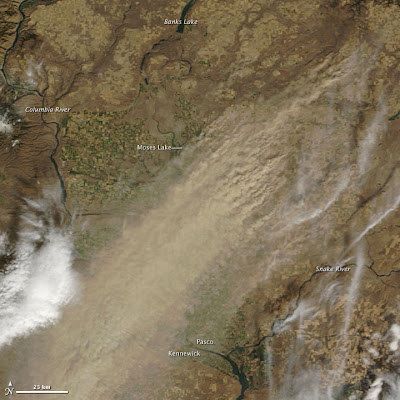I went to the Whatcom County Rural Element public hearing last week. This stuff gets wonky, political and bores the heck out most normal people. I lost normalcy on planning issues long ago in part because these processes play a fundamental role in shaping how our landscapes look and function. These decisions set up future areas of traffic jams, place large swaths of land as industrial parks with tens of thousands of jobs, create scenarios that lead to Mount Rainier being tagged as one of the most dangerous volcanoes on the planet because so many people have moved into the lahar risk zone, preserve or destroy farm land, ect. ect.
Back in January the Growth Management Hearings Board ruled Whatcom County's rural plan invalid (
digesting-lamirds-wonky-long-and-local). The County Council has decided to proceed with making the needed changes to meet the requirements of the ruling. Most of these changes are fairly straight forward, but the tough nut is dealing with an excessive amount of vacant lots that could contain essentially all of the projected County population growth over the next 20 years and beyond. The Hearings Board identified this as one problem that needs fixing and it is very unclear at this point what the County will do.
Initially the changes must go through a public process via the County Planning Commission. Process wise this is a bit interesting. The rural plan already has been through the Planning Commission process back in 2009. The Planning Commission forwarded their recommendation to the Council in late 2009. The Council spent well over a year altering and amending the original plan, and many of those alterations are what led to the plan being successfully challenged by two groups of citizens. So the Planning Commission gets to look at this plan a second time. This might seem a bit redundant as the planning commission could simply go back to the original plan and to a degree that is what the staff is recommending. However, there are couple of things to note: 1) the Planning Commission consists of people and many members are new and were not part of the original process and are decidedly different in their points of view regarding land use planning, and 2) the Hearings Board ruling has forced the County to deal with aspects of the plan that were not dealt with before.
The County staff presented some suggested changes to the Planning Commission and the public last week at a public hearing. I went to the hearing and provided some testimony and listened to some of the other testimony.
Real Estate Industry and Building Industry reps basically testified that the County should either fight the Board in court or make changes that would be clearly non compliant with the Growth Management Act. These groups have turned into cheerleader of Growth Management Act non compliance and are likely frustrated by those pesky citizens that have prevailed before the Hearings Board.
A fair number of folks in a rural area west of Bellingham testified that development in this area should be curtailed due to poor soils for septic and poor traffic. They made very valid points that are consistent with the problem of excess residential development in rural areas. Indeed soils underlying the area are very poorly drained and septic systems and stormwater are problematic in the area. Traffic issues tend to be relative, but it should be noted that much of the traffic impact is not simply in the local area but ends up in Bellingham, and hence Bellingham has taken the same position.
Jean Melious, an attorney representing a group of citizens that had successfully appealed part of the rural plan had an interesting angle to her testimony. Ms Melious was the chair of the Planning Commission during the last time the Planning Commission dealt with the rural plan. As such she has a bit of sympathy for Planning Commission members. She pointed out that after her testimony she will get to go home while they will have to continue to site through public comment and then have to struggle with all the suggestions they have heard. She raised the political angle as well. This is nothing new in testimony, but she is making it clear the fundamental struggle on dealing with land use issues is often political and in this case it very clearly has been. The majority on the County Council has pushed forward a number of plans over the past two years that have been shot down and invalidated by the Hearings Board. Clearly politics has been contrary to a State law that has been the governing land use law in most of Washington State for over 20 years.
Futurewise, another citizen group that has been part of the successful appeal of the County rural plan (disclosure - I am a Whatcom Futurewise Board member) testified a number of changes that were being proposed as good changes, but did note that excess residential development in some areas poses water quality and water quantity problems for streams and for farmers. This is no small issue when farmers can not get water rights but hundreds of homes can be built with no need for water rights as many can use exempt wells without a water right.
Dave Stalheim provided some excellent population number crunching but more importantly noted a couple scary issues: Whatcom County's rural area is on track to have a population that exceeds Bellingham and the lack of solid planning to deal with this surge of population growth in the rural areas will set up some severe future tax and utility rate problems. Mr. Stalheim is the former Whatcom County Planning Director. In some ways Mr. Stalheim is able to present information in a much freer manner as he is no longer encumbered with the political motives of his boss or the County Council.
I am sure there was plenty of other interesting testimony, but once I had testified and heard a few others I headed home and left the volunteer Planning Commission members to their hard duty - bless them.
My testimony focused on the issue of excess rural land capacity. The planning staff presented the following language for the plan on this issue:
Because of the geographic size of
Whatcom County’s rural area and the large number of existing and vested undeveloped lots, the total number of potential new dwelling units could theoretically accommodate population growth well in excess of the rural population projection. However, because adequate land capacity is available for growth within urban growth areas, growth is not forced into rural areas. Through the monitoring process described in Policies 2S-5 and 2DD-1 of this plan, the County will evaluate development activity in comparison with these urban and rural growth projections and take action as necessary to address discrepancies if any are identified.
Policy 2DD-1:
Concentrate growth in urban areas per the population projections in Chapter 1 of this plan, and recognize rural lands as an important transition area between urban areas and resource areas. Annually monitor residential development activity in rural areas and compare that data with the adopted population projection for the rural areas. If it is apparent that rural growth is occurring at a significantly higher rate than adopted projections, the County shall take action to address the discrepancy. Actions may include: changing the allocation of the projected population growth, changing rural zoning or densities, limiting rural permit issuance, working with cities to foster appropriate growth in Urban Growth Areas through annexation or extension of utilities, or working with cities to reduce the difference in impact fees between cities and rural areas.
The first paragraph recognizes the problem, but the statement that "because adequate land capacity is available for growth within urban areas, growth is not forced into rural areas," is not consistent with the growth that has been taking place over the past decade or more. In fact the urban growth areas around several of Whatcom County cities were determined to be too large and even then the rural growth rate exceeded the projections. This may be in part due to poor city planning or obstacles cities have put up towards development.
What the above does suggest is that the County recognizes the problem and will watch the situation. There is no commitment to do anything. And that is exactly what the county has already been doing. There is no commitment to anything about the problem.
I took a crack at rewriting the policy in hopes of at least getting some movement towards action and presented this scheme along with a few other comments to the planning commission during the hearing. (underlined areas showing new suggested text and cross out suggested text deletions.)
Because of the geographic size of
Whatcom County’s rural area and the large number of existing and vested undeveloped lots, the total number of potential new dwelling units could theoretically accommodate population growth well in excess of the rural population projection. However, because adequate land capacity is available for growth within urban growth areas, growth is not forced into rural areas.
However, excess growth capacity in rural areas can undermine urban development and adequate capitol facility plans have not been developed to service the excess development capacity in rural areas. Furthermore, population growth over the past few years has far exceeded the projected population growth for rural areas. Based on this rate of rural growth the County shall take actions and continue monitoring growth rates in the rural areas as
Through the monitoring process described in Policies 2S-5 and 2DD-1 of this plan, the County will
continue to evaluate development activity in comparison with these urban and rural growth projections and take action as necessary to address discrepancies if any are identified.
Policy 2DD-1:
Concentrate growth in urban areas per the population projections in Chapter 1 of this plan, and recognize rural lands as an important transition area between urban areas and resource areas. Annually monitor residential development activity in rural areas and compare that data with the adopted population projection for the rural areas. If As it is currently apparent that rural growth is occurring at a significantly higher rate than adopted projections, the county shall take the following interim actions to address the discrepancy. Actions may include: 1) limiting rural permit issuance to match projected growth rates and 2) not accept applications for land divisions other than for agricultural lease purposes on an interim basis. Additional actions following these interim actions may include but are not limited to: 1) changing the allocation of the projected population growth; if projected population allocation changes are made, they will be made in coordination with all of the cities in Whatcom County and may require the reduction of urban growth areas, 2) Develop capital facilities and service plans for serving rural areas, 3) changing rural zoning or densities based on available water resources, water quality protection, protection of identified agricultural areas, and protection of identified wildlife habitat areas, 4) working with cities to foster appropriate growth in Urban Growth Areas and within existing cities through annexation or extension of utilities, 5) working with cities to reduce the difference in impact fees between cities and rural areas by implementing school, transportation, park impact fees in rural areas as appropriate, 6) expire old plat applications, 7) consolidate existing substandard lots.
Rationale: The County has for a long time had excess growth capacity within the rural areas of the county. There is clear evidence that rural growth has been exceeding projected population growth. This problem has only been sporadically addressed within limited areas. At this point the county has very limited capital facilities plans for serving such a potentially large rural population. The excess growth capacity must be dealt with in order to protect tax payers and utility rate payers, protect agricultural lands, critical water resources and identified habitat areas.





















































